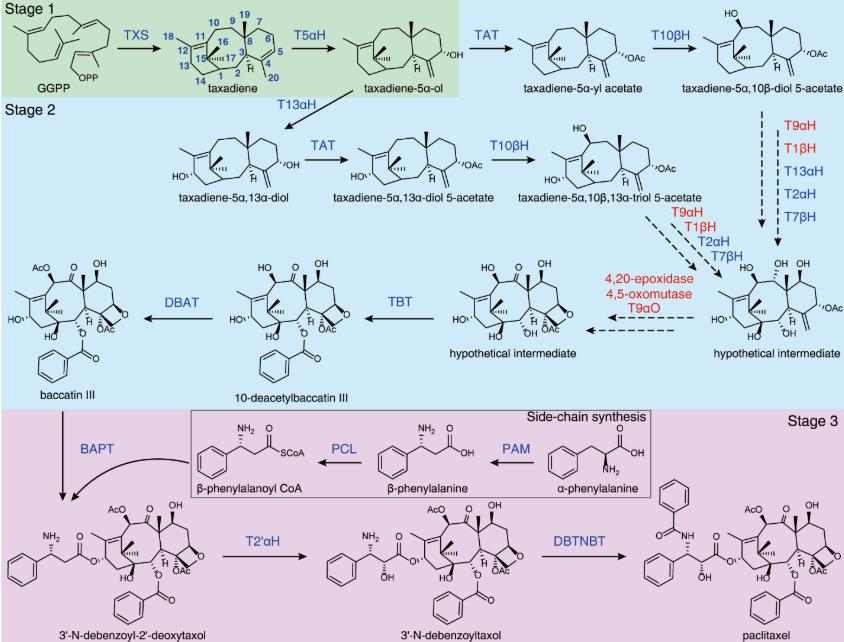What are taxadiene?
Taxadiene (C20H32), a key diterpene hydrocarbon, serves as the pivotal biosynthetic precursor for Taxol. Its biosynthesis begins with the cyclization of geranylgeranyl pyrophosphate (GGPP) catalyzed by taxadiene synthase (TXS), forming the unique tricyclic scaffold. As the first committed intermediate in Taxol biosynthesis, taxadiene quantification and structural analysis are critical for:
- Drug development: Monitoring flux through the Taxol biosynthetic pathway in Taxus species or engineered microbial systems.
- Metabolic engineering: Optimizing heterologous production of taxadiene in E. coli or yeast chassis.
- Quality control: Ensuring purity in commercial taxadiene batches for pharmaceutical intermediates.
Creative Proteomics delivers taxadiene analysis services tailored to accelerate research and industrial workflows.
Taxadiene Analysis Service by Creative Proteomics
Creative Proteomics provides a wide range of specialized services for Taxadiene analysis to ensure high-precision data back your research and development processes. Our service offerings include:
1. Taxadiene ldentification and Quantification
- Targeted GC-MS or LC-MS/Ms analysis for accurate quantification of taxadiene
- Absolute and relative quantification with internal standards
- Detection sensitivity at trace levels in plant extracts, microbial cultures, or engineered systems
2.Pathway Profiling and Metabolite Analysis
- comprehensive metabolic profiling to identify taxadiene biosynthetic intermediates
- Monitoring of taxadiene pathway fluxes using stable isotope labeling (SIL)
- Comparative analysis of engineered strains for metabolic optimization
3. Structural Characterization
- High-resolution MS and MS/MS analysis for taxadiene structural elucidation
- Fragmentation pattern analysis to determine molecular structure and confirm identity
4. Isotope Tracing Studies
- Quantifying metabolic rates by labelling paclitaxel and other paclitaxel metabolites reveals dynamic metabolic processes.
- Combined with mass spectrometry to track the binding of isotopically labelled compounds in metabolic pathways to determine metabolic rates and pathway activity.
5. Custom Assay Development
- Development and validation of customized taxadiene quantification assays
- Optimization of extraction and sample preparation protocols for diverse sample matrices
6. Data Interpretation and Report Generation
- Detailed, scientifically rigorous reports, including all relevant data, trends and analyses
- Assist in decision-making and further research
List of Taxadiene-Related Metabolites (including but not limited to)
| Detected Substance |
Type |
Metabolic Pathway |
| Taxadiene |
Diterpene |
Biosynthesis of paclitaxel from taxadiene in Taxus species |
| Taxol (Paclitaxel) |
Terpenoid |
Conversion from taxadiene via several enzymatic steps |
| 10-deacetylbaccatin III |
Precursor to Paclitaxel |
Intermediate in the paclitaxel biosynthetic pathway |
| Baccatin III |
Diterpene |
Intermediate leading to paclitaxel formation |
| 7-epi-taxol |
Taxoid derivative |
Side-product in the biosynthesis pathway |
| CYP450 Enzymes |
Enzyme family |
Key enzymes involved in hydroxylation steps in taxadiene metabolism |
| geranylgeranyl pyrophosphate(GGPP) |
Precursor |
Terpenoid synthesis precursors |
Techniques and Instrumentation for Taxadiene Analysis
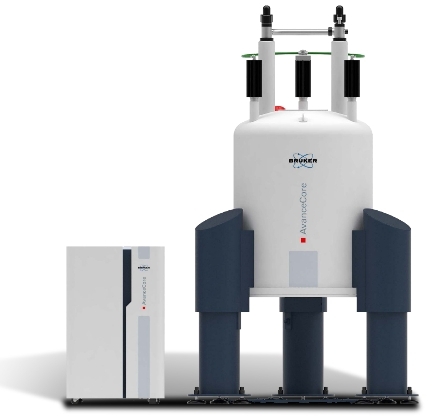 Bruker 400 MHz NMR spectrometer (Figure from Bruker)
Bruker 400 MHz NMR spectrometer (Figure from Bruker)
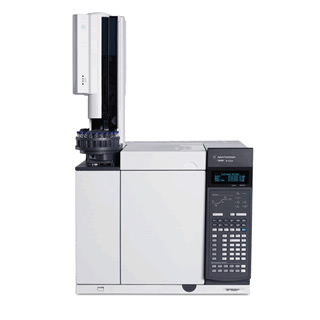 7890B Gas Chromatograph (Figure from Agilent)
7890B Gas Chromatograph (Figure from Agilent)
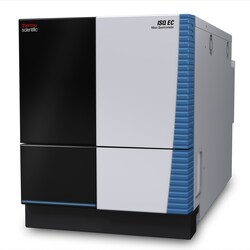 ISQ™ EC Single Quadrupole MS (Figure from Thermo Scientific)
ISQ™ EC Single Quadrupole MS (Figure from Thermo Scientific)
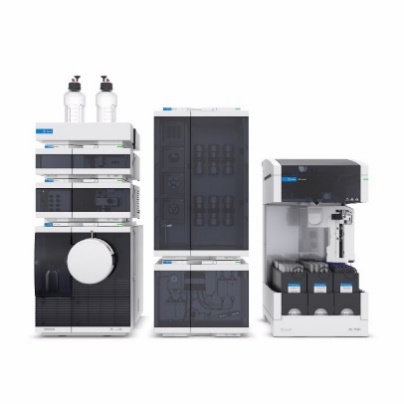 Mass-Based 1290 Infinity II Preparative LC/MSD System (Figure from Agilent)
Mass-Based 1290 Infinity II Preparative LC/MSD System (Figure from Agilent)
Workflow for Taxadiene Analysis Service
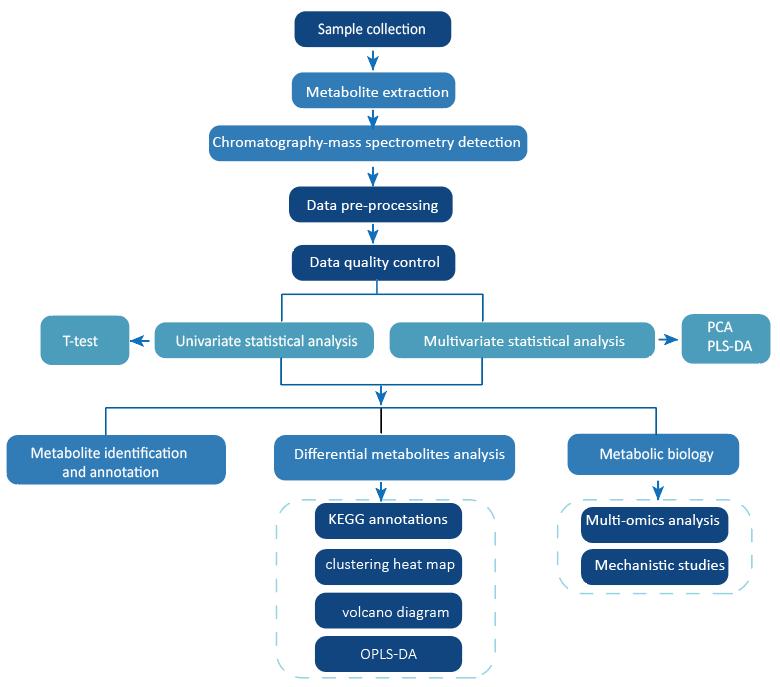
Why Choose Us?
- High Precision: We employ state-of-the-art analytical instrumentation, such as LC-MS/MS and GC-MS, to deliver highly accurate quantifications of taxadiene and its metabolites with excellent sensitivity and specificity.
- Comprehensive Metabolic Profiling: Our service provides not just a measure of taxadiene but also detailed insights into the entire metabolic pathway leading to its derivatives and final products.
- Taxane-Specific Targeted Analytical Platform: Utilizing LC-MS/MS in Multiple Reaction Monitoring mode, this system enables simultaneous quantification of 12 paclitaxel precursor compounds, with a detection sensitivity of 0.1 ng/mL and quantitative accuracy exceeding 98%.
- Customization: Tailored services that meet your specific needs, whether you're studying plant-based systems, microbial biosynthesis, or engineered strains for taxadiene production.
- Speed and Efficiency: Our advanced systems allow for fast processing times, enabling rapid turnaround without compromising quality.
- Scientific Expertise: With over 20 years of experience in biochemical and molecular analysis, our team of experts ensures that your samples are handled with the highest level of scientific integrity.
- Perfect after-sales service: Comprehensive interpretation of the final report, free technical advice, and data review service.
- Comprehensive analyses: 12 analyses, 22 graphical displays.
Applications of Taxadiene Analysis
|

|
Biotechnology and Synthetic Biology
Investigating microbial or plant-based systems engineered for the biosynthesis of taxadiene and its derivatives.
|

|
Agricultural Science
Understanding the genetic and environmental factors that influence taxadiene production in Taxus species or other plants
|
|

|
Pharmacology and Drug Development
Studying the pathways that lead to paclitaxel production and optimizing taxadiene biosynthesis for pharmaceutical applications.
|

|
Academic Research
Map taxadiene's role in plant defense mechanisms
|
Sample Requirements for Taxadiene Analysis Assay
| Sample Types |
Minimum Quantity |
Required Conditions |
| Plant Tissues |
500 mg |
Freeze-dried or fresh samples, stored at -80°C |
| Microbial cultures |
10-50 mL |
Liquid cultures grown under controlled conditions |
| Plant extracts |
2-5 mL |
Extracts should be in organic solvents like methanol or ethanol |
| Cell cultures (suspension) |
1-5 mL |
Harvest cells in mid-log phase, flash-frozen |

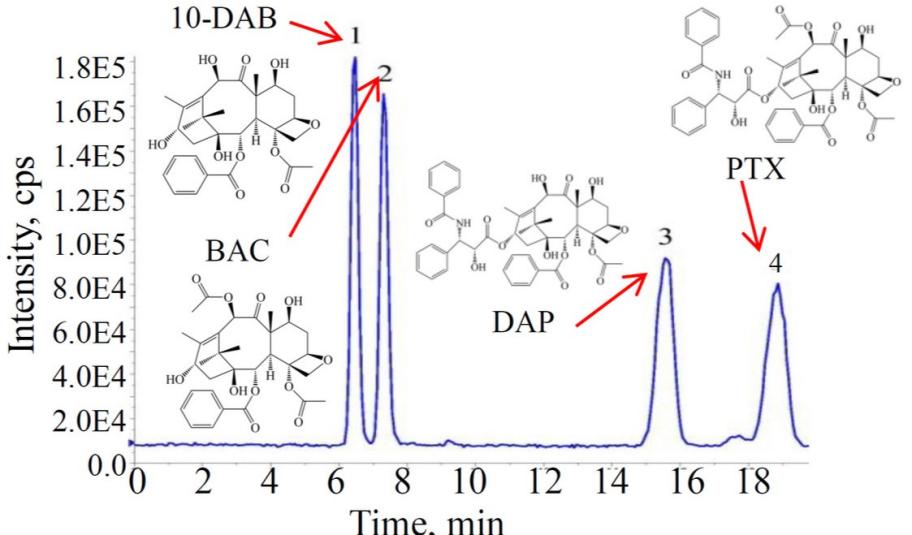 Chromatogram displaying intensity vs. time for 10-DAB, BAC, DAP, and PTX compounds with cps values ranging from 1.8E5 to 2.0E4 (Figure from Chunna Yu et al., 2020)
Chromatogram displaying intensity vs. time for 10-DAB, BAC, DAP, and PTX compounds with cps values ranging from 1.8E5 to 2.0E4 (Figure from Chunna Yu et al., 2020)


 Bruker 400 MHz NMR spectrometer (Figure from Bruker)
Bruker 400 MHz NMR spectrometer (Figure from Bruker) 7890B Gas Chromatograph (Figure from Agilent)
7890B Gas Chromatograph (Figure from Agilent) ISQ™ EC Single Quadrupole MS (Figure from Thermo Scientific)
ISQ™ EC Single Quadrupole MS (Figure from Thermo Scientific) Mass-Based 1290 Infinity II Preparative LC/MSD System (Figure from Agilent)
Mass-Based 1290 Infinity II Preparative LC/MSD System (Figure from Agilent)




 Chromatogram displaying intensity vs. time for 10-DAB, BAC, DAP, and PTX compounds with cps values ranging from 1.8E5 to 2.0E4 (Figure from Chunna Yu et al., 2020)
Chromatogram displaying intensity vs. time for 10-DAB, BAC, DAP, and PTX compounds with cps values ranging from 1.8E5 to 2.0E4 (Figure from Chunna Yu et al., 2020)